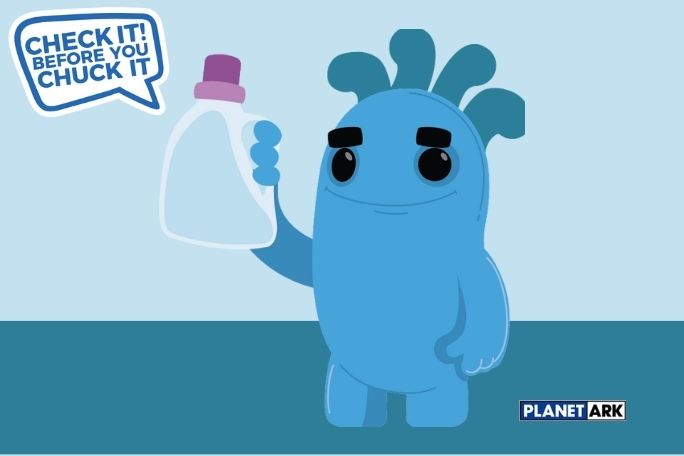Lesson summary
Planet Ark knows Australians and New Zealanders care about the environment and want to do the right thing. The ARL removes the confusion around recycling a variety of packaging materials, ultimately improving our recycling behaviours for the better.
But is the message getting through to the general public? Or are they still confused about or unaware of the purpose and benefits of the ARL?
In this lesson students assume the role of marketing executives, analysing the persuasive marketing techniques and aesthetic choices used by the Check It! Before You Chuck It campaign to promote the message of the ARL. Students will then focus their own persuasive creativity to create a marketing campaign which either advertises and explains the ARL or pitches a change to recyclable packaging at their company. Students will share these messages with specific audiences in their role as advocates for the ARL.
Learning intentions:
Students will...
- understand the structure, format, purpose and techniques of advertising material
- understand the purpose and environmental benefits of the ARL.
Success criteria:
Students can...
- critically evaluate media communication pieces
- think persuasively
- think empathetically to understand the perspectives of others
- advocate for the ARL and the benefits of recycling.
Lesson guides and printables
Lesson details
Curriculum mapping
Australian Curriculum content descriptions:
Year 5 English:
- Plan, draft and publish imaginative, informative and persuasive print and multimodal texts, choosing text structures, language features, images and sound appropriate to purpose and audience (ACELY1704)
- Use a range of software including word processing programs with fluency to construct, edit and publish written text, and select, edit and place visual, print and audio elements (ACELY1707)
Year 6 English:
- Plan, draft and publish imaginative, informative and persuasive texts, choosing and experimenting with text structures, language features, images and digital resources appropriate to purpose and audience (ACELY1714)
- Use a range of software, including word processing programs, learning new functions as required to create texts (ACELY1717)
Year 5 Science:
- Scientific knowledge is used to solve problems and inform personal and community decisions (ACSHE100)
Year 6 Science:
- Scientific knowledge is used to solve problems and inform personal and community decisions (ACSHE083)
Syllabus outcomes: EN3-2A, ST3-7PW
General capabilities: Literacy, Information and Communication Technology (ICT) Capability, Critical and Creative Thinking
Cross-curriculum priority: Sustainability
Relevant parts of Year 5 English achievement standards: Students listen and ask questions to clarify content. They use language features to show how ideas can be extended. Students develop and explain a point of view about a text, selecting information, ideas and images from a range of resources. They create imaginative, informative and persuasive texts for different purposes and audiences. Students make presentations that include multimodal elements for defined purposes. They contribute actively to class and group discussions, taking into account other perspectives.
Relevant parts of Year 6 English achievement standards: Students listen to discussions, clarifying content and challenging others’ ideas. They understand how language features and language patterns can be used for emphasis. Students show how specific details can be used to support a point of view. They explain how their choices of language features and images are used. Students create detailed texts elaborating on key ideas for a range of purposes and audiences. They make presentations and contribute actively to class and group discussions, using a variety of strategies for effect.
Relevant parts of Year 5 Science achievement standards: Students discuss how scientific developments have affected people’s lives, help us solve problems and how science knowledge develops from many people’s contributions
Relevant parts of Year 6 Science achievement standards: Students explain how scientific knowledge helps us to solve problems and inform decisions and identify historical contributions
This lesson is part of the wider unit of work Australasian Recycling Label
Time required: 60 mins
Level of teacher scaffolding: Medium – facilitate students as they curate content, develop persuasive techniques and use multimedia to create marketing campaigns
Resources required
- Art supplies – coloured pencils and paper
- A device capable of presenting a video to the class
- Individual devices capable of accessing the internet – one per student
- Planet Ark assets
- A whiteboard
Skills
This lesson is designed to build students’ competencies in the following skills:
- Communication
- Community engagement
- Creativity
- Critical thinking
- Digital literacy
- Ethical understanding
- Global citizenship
- Problem solving
- Social skills
- Collaboration
Additional info
This lesson has been developed as part of Planet Ark’s campaign around the Australasian Recycling Label and sustainable packaging. You can get involved during Planet Ark’s National Recycling Week or at any time during the school year and join thousands of amazing teachers in making a difference and creating positive environmental change. If you use any of these lessons, we highly recommend you submit an entry for the School’s Recycle Right Challenge in Term 4 and enter in the draw to win amazing prizes for your school!


Welcome back!
Don't have an account yet?
Log in with:
By signing up to Cool.org you consent and agree to Cool's privacy policy to
store, manage and process your personal information. To read more, please see
our privacy policy here(Opens in new tab).
Create your free Cool.org account.
Many of our resources are free, with an option to upgrade to Cool+ for premium content.
Already have an account?
Sign up with:
By signing up to Cool.org you consent and agree to Cool's privacy policy to
store, manage and process your personal information. To read more, please see
our privacy policy here(Opens in new tab).